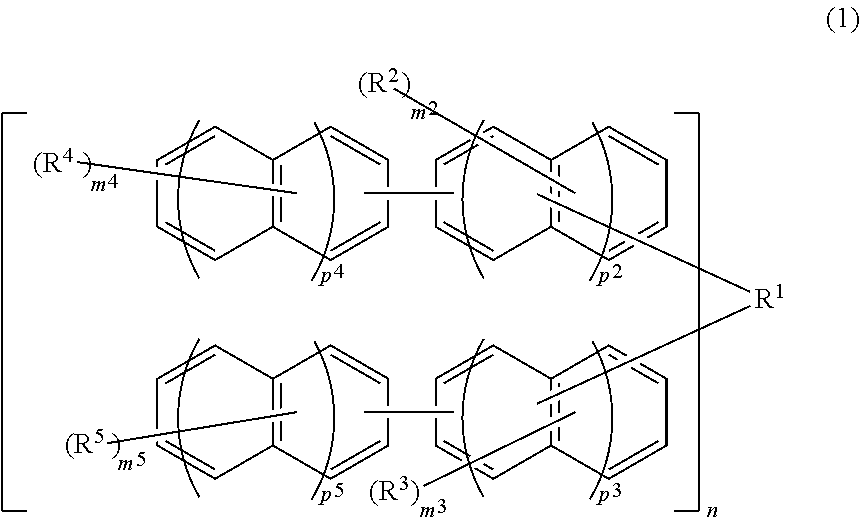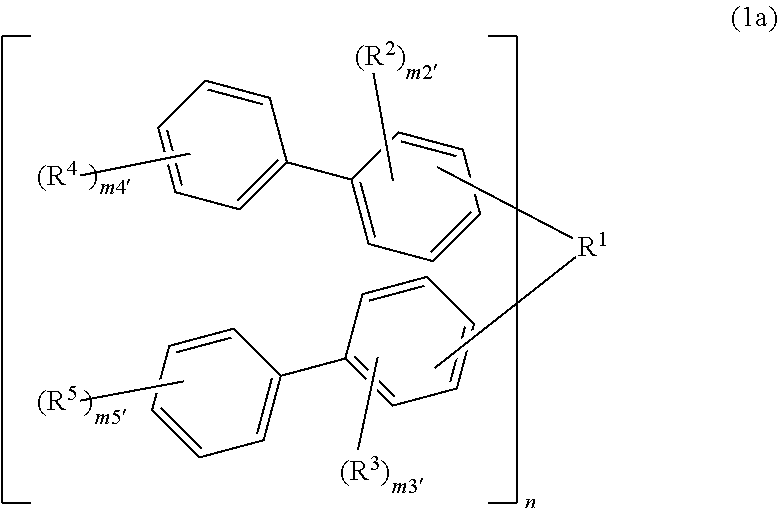Compound, resin, resist composition or radiation-sensitive composition, resist pattern formation method, method for producing amorphous film, underlayer film forming material for lithography, composition for underlayer film formation for lithography, method for forming circuit pattern, and purification method
a technology of resist composition and resin, applied in the field of compound resin, can solve the problems of difficult control of pattern dimension, reduced yield, rough surface of fine pattern surface, etc., and achieve the effects of good resist pattern, high heat resistance, and high solubility
- Summary
- Abstract
- Description
- Claims
- Application Information
AI Technical Summary
Benefits of technology
Problems solved by technology
Method used
Image
Examples
synthesis example 1
[Synthesis Example 1] Synthesis of BisF-1
[0423]A container (internal capacity: 200 mL) equipped with a stirrer, a condenser tube, and a burette was prepared. To this container, 30 g (161 mmol) of 4,4-biphenol (a reagent manufactured by Tokyo Kasei Kogyo Co., Ltd.), 15 g (82 mmol) of 4-biphenylaldehyde (manufactured by Mitsubishi Gas Chemical Company Inc.), and 100 mL of butyl acetate were added, and 3.9 g (21 mmol) of p-toluenesulfonic acid (a reagent manufactured by Kanto Chemical Co., Inc.) was added to prepare a reaction solution. The reaction solution was stirred at 90° C. for 3 hours and reacted. Next, the reaction solution was concentrated. The reaction product was precipitated by the addition of 50 g of heptane. After cooling to room temperature, the precipitates were separated by filtration. The solid matter obtained by filtration was dried and then separated and purified by column chromatography to obtain 5.8 g of the objective compound (BisF-1) represented by the following...
synthesis working example 1
[Synthesis Working Example 1] Synthesis of BisF-1-BOC
[0427]To a container (internal capacity: 200 mL) equipped with a stirrer, a condenser tube, and a burette, 6.7 g (12.5 mmol) of the obtained compound (BisF-1) and 11.0 g (50 mmol) of di-t-butyl dicarbonate (manufactured by Sigma-Aldrich) were added with 100 mL of acetone, then 6.9 g (50 mmol) of potassium carbonate (manufactured by Sigma-Aldrich) was added, and the contents were reacted by being stirred at 20° C. for 6 hours to obtain a reaction solution. Next, the reaction solution was concentrated. The reaction product was precipitated by the addition of 100 g of pure water to the concentrate. After cooling to room temperature, the solid matter was separated by filtration.
[0428]The obtained solid matter was subjected to filtration, dried, and then separated and purified by column chromatography to obtain 2 g of the objective compound (BisF-1-BOC) represented by the following formula (BisF-1-BOC).
[0429]As a result of measuring th...
synthesis working example 2
[Synthesis Working Example 2] Synthesis of BisF-I-1-BOC
[0436]To a container (internal capacity: 200 mL) equipped with a stirrer, a condenser tube, and a burette, 7.3 g (12.5 mmol) of the obtained compound (BisF-I-1) and 11.0 g (50 mmol) of di-t-butyl dicarbonate (manufactured by Sigma-Aldrich) were added with 100 mL of acetone, then 6.9 g (50 mmol) of potassium carbonate (manufactured by Sigma-Aldrich) was added, and the contents were reacted by being stirred at 20° C. for 6 hours to obtain a reaction solution. Next, the reaction solution was concentrated. The reaction product was precipitated by the addition of 100 g of pure water to the concentrate. After cooling to room temperature, the solid matter was separated by filtration.
[0437]The obtained solid matter was subjected to filtration, dried, and then separated and purified by column chromatography to obtain 2 g of the objective compound (BisF-I-1-BOC) represented by the following formula (BisF-I-1-BOC).
[0438]As a result of meas...
PUM
| Property | Measurement | Unit |
|---|---|---|
| molecular weight distribution | aaaaa | aaaaa |
| temperature | aaaaa | aaaaa |
| temperature | aaaaa | aaaaa |
Abstract
Description
Claims
Application Information
 Login to View More
Login to View More - R&D
- Intellectual Property
- Life Sciences
- Materials
- Tech Scout
- Unparalleled Data Quality
- Higher Quality Content
- 60% Fewer Hallucinations
Browse by: Latest US Patents, China's latest patents, Technical Efficacy Thesaurus, Application Domain, Technology Topic, Popular Technical Reports.
© 2025 PatSnap. All rights reserved.Legal|Privacy policy|Modern Slavery Act Transparency Statement|Sitemap|About US| Contact US: help@patsnap.com



